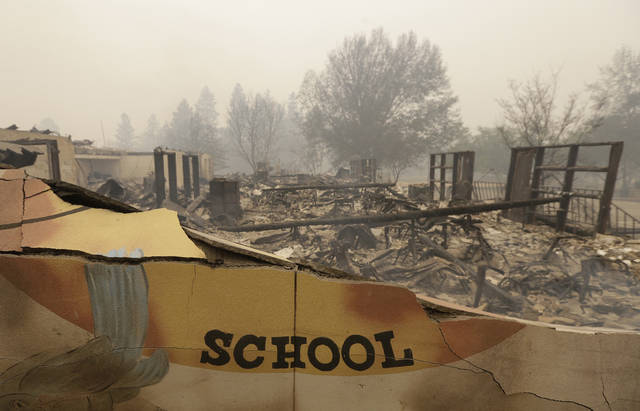PARADISE, Calif. — With hugs, teachers and a touch of anxiety, thousands of children returned to school and some semblance of routine Monday, three weeks after Northern California’s deadly wildfire destroyed their homes and classrooms.
Schools in Butte County have been closed since Nov. 8, when the blaze swept through the towns of Paradise, Concow and Magalia in the nation’s deadliest wildfire in a century. At least 88 people were killed and dozens remain unaccounted for.
About 31,000 students in all went back to school. Many of them are going to class in other buildings because their schools were damaged or destroyed, or are inaccessible inside evacuation zones.
Some families have left the state. Others are staying with friends or relatives, too far from the fire-stricken area to drive in every day.
But nearly all the teachers are returning to provide a familiar and comfortable face to the children who are able to make it to class.
“It’s important that the kids are able to stay together and have some sort of normalcy in the crazy devastation that we’re having now,” said Jodi Seaholm, whose daughter Mallory is a third-grader.
Mallory underwent radiation in October to treat a recurrence of brain cancer and showed no fear, Seaholm said, but “this situation with her house burning down has absolutely devastated her.”
Counselors brought in from around the country were in nearly every classroom Monday to help children who were distressed by their escape through a burning town and the loss of their homes, Paradise Superintendent Michelle John said at a celebratory news conference. Many of the teachers lost their homes as well.
“Our kids are traumatized,” John said. “Their families are traumatized.”
Two neighboring school districts have allowed children from Paradise to take over available space. Kids who previously went to Paradise Elementary are going to school in Oroville, while children from Ponderosa Elementary are going to a school in Durham.
Most of Paradise High School survived but is inaccessible.
The district doesn’t have space yet for intermediate and high school classrooms, so for the 13 days before the holiday break begins, those students will learn through independent study. They will have access to online assignments and a drop-in center at the Chico mall where they can get help from teachers or see classmates.
But schoolwork will probably be secondary to dealing with trauma and reconnecting with friends, said Paradise High Principal Loren Lighthall.
“They don’t have their church, they don’t have their school, they don’t have their work, they don’t have their friends. They don’t have any of that stuff and we’re asking them to write five-paragraph essays?” Lighthall said. “It’s just unreasonable at this point. We’re going to do it, but we’re going to be super flexible with what we require.”
Marissa Nypl is living with her family at her husband’s coworker’s home in West Sacramento, which is 90 miles (145 kilometers) from her 10-year-old daughter’s temporary school in Durham, until they can move into a rental home much closer.
It’s too far to drive every day, but Nypl wanted to be sure her daughter was there to be with her peers on the first day back.
“The school’s going to be the only thing they have to latch on to to feel like something’s still routine,” she said.


